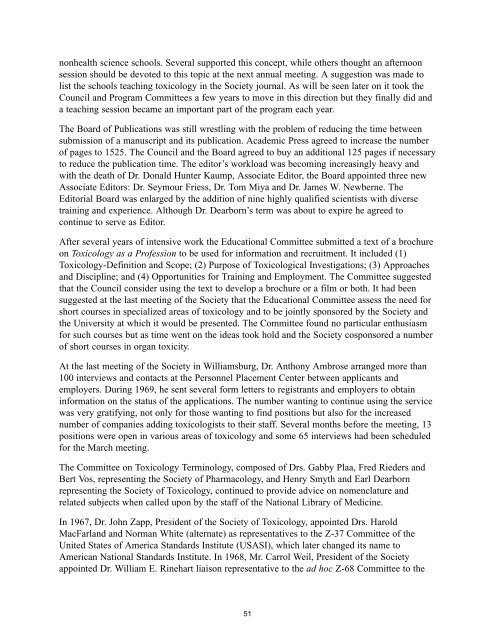SOCIETY O. TOXICOLOGY HISTORY - Society of Toxicology
SOCIETY O. TOXICOLOGY HISTORY - Society of Toxicology
SOCIETY O. TOXICOLOGY HISTORY - Society of Toxicology
Create successful ePaper yourself
Turn your PDF publications into a flip-book with our unique Google optimized e-Paper software.
nonhealth science schools. Several supported this concept, while others thought an afternoon<br />
session should be devoted to this topic at the next annual meeting. A suggestion was made to<br />
list the schools teaching toxicology in the <strong>Society</strong> journal. As will be seen later on it took the<br />
Council and Program Committees a few years to move in this direction but they finally did and<br />
a teaching session became an important part <strong>of</strong> the program each year.<br />
The Board <strong>of</strong> Publications was still wrestling with the problem <strong>of</strong> reducing the time between<br />
submission <strong>of</strong> a manuscript and its publication. Academic Press agreed to increase the number<br />
<strong>of</strong> pages to 1525. The Council and the Board agreed to buy an additional 125 pages if necessary<br />
to reduce the publication time. The editor’s workload was becoming increasingly heavy and<br />
with the death <strong>of</strong> Dr. Donald Hunter Kaump, Associate Editor, the Board appointed three new<br />
Associate Editors: Dr. Seymour Friess, Dr. Tom Miya and Dr. James W. Newberne. The<br />
Editorial Board was enlarged by the addition <strong>of</strong> nine highly qualified scientists with diverse<br />
training and experience. Although Dr. Dearborn’s term was about to expire he agreed to<br />
continue to serve as Editor.<br />
After several years <strong>of</strong> intensive work the Educational Committee submitted a text <strong>of</strong> a brochure<br />
on <strong>Toxicology</strong> as a Pr<strong>of</strong>ession to be used for information and recruitment. It included (1)<br />
<strong>Toxicology</strong>-Definition and Scope; (2) Purpose <strong>of</strong> Toxicological Investigations; (3) Approaches<br />
and Discipline; and (4) Opportunities for Training and Employment. The Committee suggested<br />
that the Council consider using the text to develop a brochure or a film or both. It had been<br />
suggested at the last meeting <strong>of</strong> the <strong>Society</strong> that the Educational Committee assess the need for<br />
short courses in specialized areas <strong>of</strong> toxicology and to be jointly sponsored by the <strong>Society</strong> and<br />
the University at which it would be presented. The Committee found no particular enthusiasm<br />
for such courses but as time went on the ideas took hold and the <strong>Society</strong> cosponsored a number<br />
<strong>of</strong> short courses in organ toxicity.<br />
At the last meeting <strong>of</strong> the <strong>Society</strong> in Williamsburg, Dr. Anthony Ambrose arranged more than<br />
100 interviews and contacts at the Personnel Placement Center between applicants and<br />
employers. During 1969, he sent several form letters to registrants and employers to obtain<br />
information on the status <strong>of</strong> the applications. The number wanting to continue using the service<br />
was very gratifying, not only for those wanting to find positions but also for the increased<br />
number <strong>of</strong> companies adding toxicologists to their staff. Several months before the meeting, 13<br />
positions were open in various areas <strong>of</strong> toxicology and some 65 interviews had been scheduled<br />
for the March meeting.<br />
The Committee on <strong>Toxicology</strong> Terminology, composed <strong>of</strong> Drs. Gabby Plaa, Fred Rieders and<br />
Bert Vos, representing the <strong>Society</strong> <strong>of</strong> Pharmacology, and Henry Smyth and Earl Dearborn<br />
representing the <strong>Society</strong> <strong>of</strong> <strong>Toxicology</strong>, continued to provide advice on nomenclature and<br />
related subjects when called upon by the staff <strong>of</strong> the National Library <strong>of</strong> Medicine.<br />
In 1967, Dr. John Zapp, President <strong>of</strong> the <strong>Society</strong> <strong>of</strong> <strong>Toxicology</strong>, appointed Drs. Harold<br />
MacFarland and Norman White (alternate) as representatives to the Z-37 Committee <strong>of</strong> the<br />
United States <strong>of</strong> America Standards Institute (USASI), which later changed its name to<br />
American National Standards Institute. In 1968, Mr. Carrol Weil, President <strong>of</strong> the <strong>Society</strong><br />
appointed Dr. William E. Rinehart liaison representative to the ad hoc Z-68 Committee to the<br />
51
















